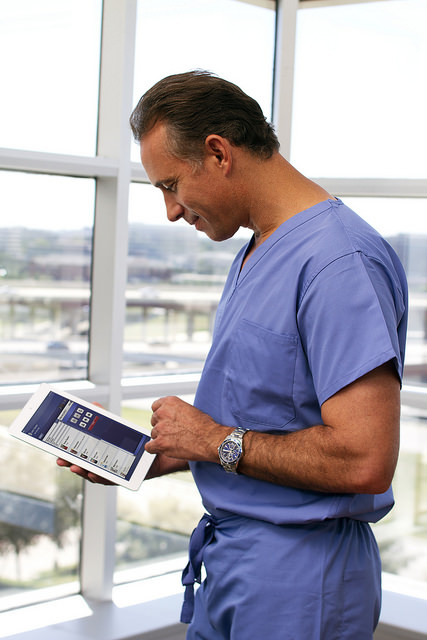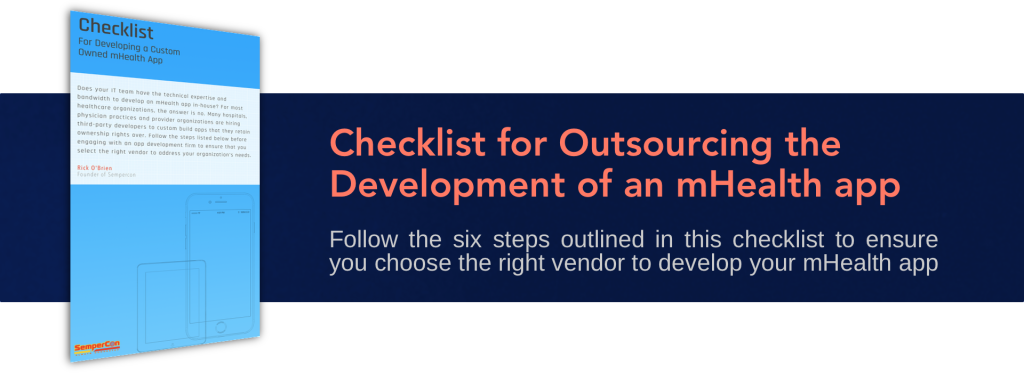It’s predicted that the mobile healthcare (mHealth) technology market may grow 33% to a market value of $59.15 billion by the year 2020. mHealth apps that improve clinical workflows, patient engagement and other measures of quality of care are already unlocking millions in savings for hospitals and other health systems. Just as EHRs have become a requirement for care delivery, so will well-designed mHealth apps.
In order to develop winning mHealth apps, developers can not rely on their technical knowledge base alone. A deep understanding of healthcare—with its many complex processes, regulations and IT requirements—is essential for early stage and aspiring mHealth entrepreneurs and developers. We’ve compiled a list of facts from surveys, studies and reports that illustrate current receptivity to mHealth, industry growth estimates and opportunities for development. Take a look:
Healthcare professionals’ perception and adoption of mHealth
-
72 percent of surveyed healthcare professionals predict that patients who use health apps will take more responsibility for their health. (Source: ResearchNow)
-
50 percent of providers think mHealth apps will make patient treatment more efficient and 46 percent think mHealth apps will improve their relationships with patients. (Source: ResearchNow)
-
61 percent of healthcare professionals believe mHealth apps can help patients who are at-risk for developing health issues (Source: ResearchNow)
-
48 percent of healthcare professionals think mHealth apps could potentially help patients who were recently discharged from a hospital. (Source: ResearchNow)
-
80 percent of doctors are willing to use tablets at work (Source: Samsung Business)
-
69 percent of healthcare providers use mobile devices to view patient data (Source: Samsung Business)
Opportune Pathways for mHealth Developers
-
46 percent of healthcare professionals want to introduce smartphone apps into their practice within the next five years (Source: ResearchNow)
-
79 percent of surveyed care providers are open to using analytics and decision support tools capable of turning raw patient data into actionable knowledge. (Source: Fierce Mobile Healthcare IT)
-
56% of consumers 18-34 would use a service that helped them plan medical expenses (Source: PwC)
-
mHealth apps that provide evidence-based clinical guidelines to clinicians improved nurses’ ability to accurately screen and diagnose patients with mental and physical health ailments by 4 to 44X. (Source: Columbia University School of Nursing)
-
Just 30 percent of health consumers use mHealth apps to keep track of existing health conditions and 29 percent to remind them to take medication (Source: ResearchNow)
-
34 percent of mobile health and fitness app users would increase their use of mHealth apps if their doctors recommended it (Source: Healthcare Informatics)
-
Doctors say they have anywhere from 2 seconds to 5 minutes to get the information they need—including typing in terms and reading articles—when using digital tools for clinical decision support (Source: EBSCO Health)
-
Doctors tend to use digital tools and resources that don’t require security checks to get quick answers to their clinical decision related questions at the point of care (Source: EBSCO Health)
-
Women make 80% of healthcare decisions for families and manage healthcare-related responsibilities such as researching information, selecting insurance plans and providers, and deciding between treatments options (Source: Rock Health)
-
In 2012, physician office visits per 100 persons reached 342 amongst women versus 258 visits amongst men. (Source: Rock Health)
-
Healthcare spending per capita for working-age females is 29% higher than male per capita spending, and for females ages 19-44 per capita spending is 70% more than their male counterparts (Source: Rock Health)
-
Pilot trial suggests that health and wellness apps that go beyond allowing users to track their activity changes, encouraging them to make behavioral changes, has a much greater impact on health outcomes. (Source: Journal of the American Heart Association)
-
Since 2010, diabetes has consistently been considered the therapy field offering the strongest business proposition for mHealth (Source: Research2Guidance)
-
70 percent of mHealth practitioners rated diabetes highest for its market potential over the next five years, followed by hypertension (29 percent), depression, (23 percent), and coronary heart disease (16 percent) (Source: Research2Guidance)
-
Hispanics are nearly three times more likely than non-Hispanics to use a mobile device for health-related reasons such as scheduling an appointment or purchasing care, and are more willing to use technology to monitor health by checking vital signs or glucose levels. (Source: PwC)
-
95% of Hispanics believe it is important to obtain an accurate price for health services—compared with 82% of non-Hispanics—and will often ask about cost before going to the doctor or having a procedure done. (Source: PwC)
Patient perception and adoption of mHealth
-
73 percent of consumers rated the privacy of their medical records as more important than convenience of access (Source: PwC)
-
60 percent of consumers rated privacy of their diet and fitness data as more important than convenience of access (Source: PwC)
-
83 percent of consumers are willing to share to aid in diagnosing and treating themselves (Source: PwC)
-
73 percent of consumers are willing to share to aid in diagnosing and treating others (Source: PwC)
-
96 percent of patients agree mHealth apps can help improve their quality of life (Source: ResearchNow)
-
60 percent of consumers use health apps to help them monitor activity and workouts, 53 percent use them to motivate them to exercise, 49 percent to record calorie intake, and 42 percent to monitor weight loss (Source: ResearchNow)
-
Thirty two percent of users share app-collected health data with their doctors (Source: ResearchNow)
-
70 percent of people use mobile apps on a daily basis to track calorie intake and monitor physical activities (Source: Mobiquity)
-
73 percent of health consumers believe themselves to be healthier by using mHealth apps to track their health and fitness (Source: Mobiquity)
-
53 percent of health consumers discovered they were eating more calories than they realized by using health and wellness tracking apps (Source: Mobiquity)
-
Eighty percent of US adult smartphone users said they expect doctors to offer key services via an app within two years (Source: Apigee)
-
41 percent of adult smartphone users in national survey said they would never pay anything for a health app, 20 percent would pay only up to $1.99, while 23 percent said they pay at most between $2 and $5.99. (Source: NYU Langone Medical Center)
Segmented &overall growth trends
-
Healthcare and fitness apps currently dominate the mHealth software market, claiming 33.7 percent market share as of 2014 (Source: Fierce Mobile Healthcare IT)
-
Remote patient monitoring (RPM) is leading the services segment for mHealth with 63.7 percent market share (Source: Fierce Mobile Healthcare IT)
-
66 percent of surveyed care providers are utilizing remote patient monitoring (Source: Fierce Mobile Healthcare IT)
-
84 percent of surveyed care providers are using mobile devices, primarily tablets, for post-hospital discharge support (Source: Fierce Mobile Healthcare IT)
-
The percentage of consumers with at least one medical, health or fitness app on their smartphones doubled from 2013 to 2015 (Source: PwC)
-
According to research on the diffusion of innovation, 67 percent market penetration is the threshold for reaching half of the ‘late majority’ of technology adopters. Researchers predict mHealth apps will reach this threshold in 2017 (Source: Apigee)


